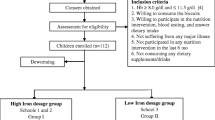Abstract
Objective : To develop an iron rich supplement with locally available foods and to test its feasibility in school going children (7–9 Years) belonging to low income families.Methods : From the upper primary school in Rajendranagar 7–9 year-old children were screened for hemoglobin (Hb) levels and 36 children having Hb levels below 11 g/dl were selected. Based on their Hb levels, age, and gender, 24 children were grouped as experimental and the rest as control. A supplement food (laddoo) was developed using locally available foods like jaggery, processed rice flakes, graden cress seeds and amaranth seeds (45:40:10.5). In the experimental group, children were given oneladdoo per day for a period of 60 days. Effect of supplement on Hb levels, height and weight was assessed.Result : Anthropometric parameters showed that 97% of these children were undernourished, majority (50%) were in grade II malnutrition followed by grade (25%) and grade II (22%). A significant increase in Hb levels was observed in both the boys and girls after 30 days of supplementation only. The increase was comparatively more in the first 30 days than the second 30 days. The overall increase in Hb levels was more in 7–8 years than the 8–9 years age group. In majority of the subjects progression from one Hb level to the next higher level was observed. There was no significant improvement in their height and weight.Conclusion : The product developed contributed around 39-mg% iron. Thus its efficacy as an iron rich supplement in combating iron deficiency anemia is reflected in the results obtained.
Similar content being viewed by others
References
Picciano ME. Iron and folate supplementation: An effective intervention in adolescent females.Am J Clin Nutr 1999; 69 : 1069–1070.
Berger J, Schneider D, Dyck Jet al. Iron deficiency, cell-mediated immunity and infection among 6–36 month old children living in rural Togo.Nurt Res 1992; 12: 39–49.
Mathur B, Joshi RN, Bray WJ. Impact of supplementing leaf protein concentrate on haemoglobin levels of children.Indian J of Nutr Diet 1989; 26: 267–271.
Sarwate N, Sharma K, Singh SD. Impact of supplementing indigenous sweet (Laddoo) on haemoglobin level of anaemic children.Indian J of Nutr Diet 1994; 31: 262–264.
Gopalan C, Sastri BVR, Balasubramanian SC.Nutritive value of Indian Foods. National Institute of Nutrition, Indian Council of Medical Research, 1996.
Carwright GE. Estimation of haemoglobin. In Grune NY, Strattion, eds.Diagnostic Laboratory Haematology. 4th edn. 1958; 34–44.
Peryam DR, Pilgrim JF. Hedonic scale method for measuring food preferences.Food Tech 1957; 11 (9): 9–14.
Williams S. Official methods of analysis. The association of official analytical chemists. 1984; 14 edition: Virginia, U.S.A.
Agarwal DK, Agarwal KN, Upadhyaya SK, Mittal R, Prakash R., Rai S. Physical and sexual growth pattern of affluent Indian. Children from 5–18 yrs. of age.Indian Pediatr 1992; 29: 1203–1282.
Narsinga Rao BS. Prevention and control of anaemia in India: Theory and practise.NFI Bull 1991; 12(2) : 4–8.
Youdim BHM, Ben Shanchar D and Yehuda S. Putative biological mechanisms of the effect of iron deficiency on brain biochemistry and behaviour.Am J Clin Nutr, 1989; 50: 607–617.
Qamra SR, Mehta S. and Deodhar SD. Physical growth in school girls: Relationship to socio-economic status and dietary intake.Indian Pediatr, 1990; 27 : 1051–1054.
Narsinga Rao BS, Iron deficiency anaemia and its control through iron fortified salt.Nutr News 1987; 8: 1–4.
Borigato EVM, Martinez FE. Iron incorporation in Brazillian infant diets cooked in iron utensils.Nutr Res 1992; 12: 1065–1073.
Sarojini G, Nirmalamma N, Chaturvedi A. Product development and evaluation of whole grain and flour blends ofAmaranthus paniculatus.J Food Sc and Tech 1996; 33(4): 345–347.
Rosenzweig PH, Volpe SL. Iron, thermoregulation and metabolic rate.Critical Rev in Food Sei Nutr 1999; 39(2): 131–148.
Devi GN, Rao KC. Effect of iron treatment among nutritionally vulnerable groups.J Res (Andhra Pradesh Agricultural University) 1995; 23(1) ; 12–15.
Beard JL, Borel MJ and Derr J. Impaired thermoregulation and thyroid function in iron deficiency anaemia.Am J Clin Nutr 1990; 52: 813–819.
Wintrobe M, Lee Gr, Boggs DRet al. Laboratory finding. InClinical Haematology. 8th edn. Lee and Febiger, Washington 1981; 634–639.
Bhatia D, Seshadri S. Growth performance in anaemia and following iron supplementation.Indian Pediatr 1993; 30: 195–200.
Author information
Authors and Affiliations
Corresponding author
Rights and permissions
About this article
Cite this article
Sood, M., Sharada, D. Iron food supplement. Indian J Pediatr 69, 943–946 (2002). https://doi.org/10.1007/BF02726008
Issue Date:
DOI: https://doi.org/10.1007/BF02726008




